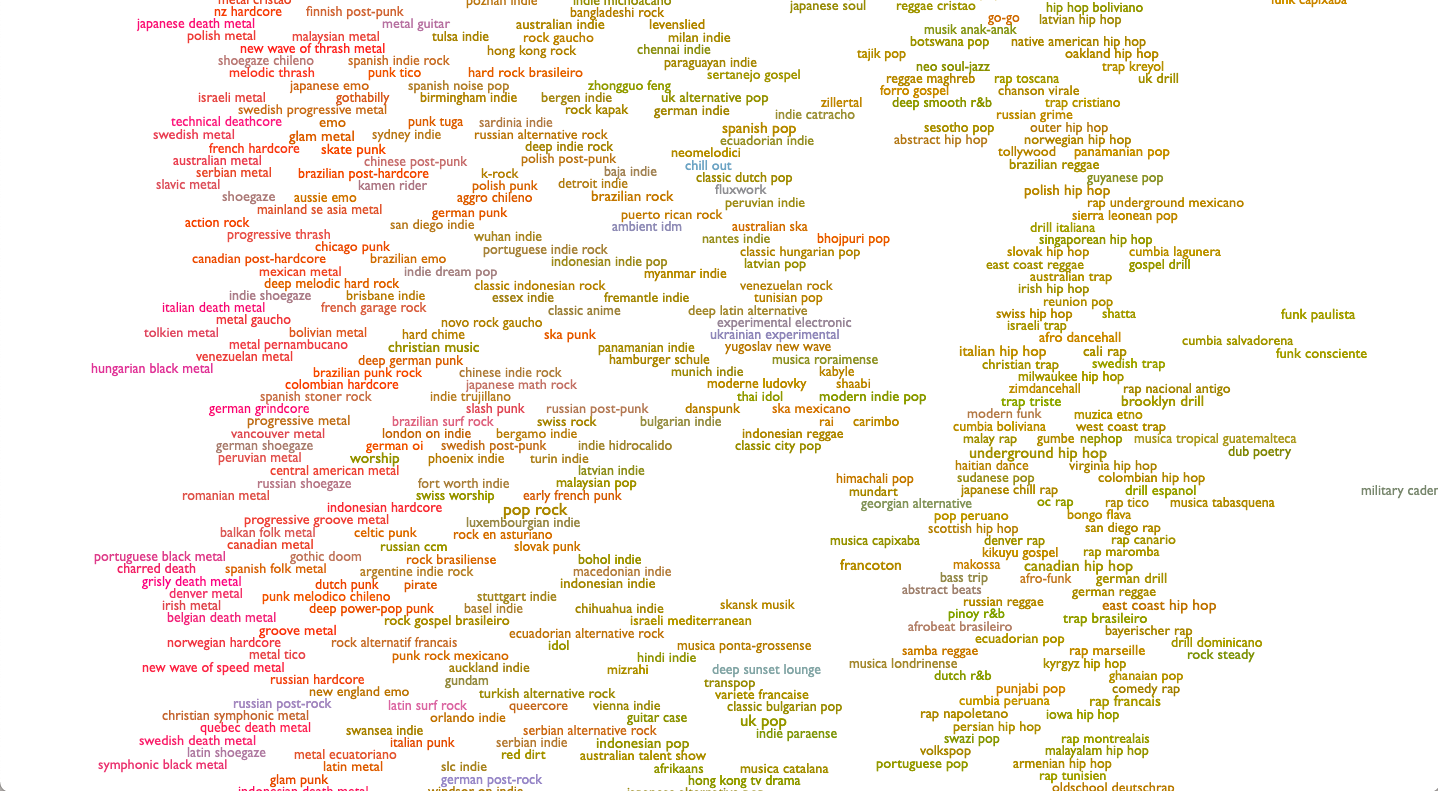By Grace McFadden
Every Noise at Once, an online data-based visualization of all music genres, started like many of Spotify Data Alchemist Glenn McDonald’s projects: a debugging tool for some part of Mcdonald’s job. At the time, McDonald had recently started at Spotify, and he’d been tasked with trying to categorize the songs on the platform.
“We were trying to use machine learning to calculate these things, to score songs on things like whether there are people singing, or whether they had acoustic or electric instruments,” he said. “It’s really hard to debug that by just looking at individual songs, so I tried to start making graphs that kind of aggregated these scores by genre. And then hopefully, you could make a little more sense of that, like, if we were trying to measure whether things were acoustic or not, you’d hope to see folk music and classical music at one end and electronic dance music at the other end. And then as I did that, I was like, this is actually kind of an interesting way to look at genres in itself.”
Each of the more than 5,000 genres represented in Every Noise at Once has several associated playlists, which are also generated by machine learning. From there, McDonald used similar techniques to generate playlists based on certain listener demographics.
“The essential insight was once you realize that looking at what’s different about the behavior of subsets of listeners is always interesting, that becomes a hammer. You start saying, ‘what other subsets are there?’ We have fans of genres, we have people in countries, we have people in cities, we have demographic slices,” McDonald said.
Most notably, McDonald is responsible for making playlists based on what songs are associated with certain universities. For example, “The Sound of the University of Connecticut” playlist features UConn-based artists JR SPECS, Kids That Fly and Tre Breezy at the top of the playlist.
The university-based playlists work by gleaning information from users who self-identify as students from a certain university to Spotify, McDonald explained.
“We have this student plan for Spotify, and when you sign up for the student plan, you actually have to say what school you’re at” he said. “ You have to answer a question about your school email or whatever it is, so we actually have some at least self identified knowledge about what school people on the student plan are from. Then we can find out what’s different about students listening as well. ”
From there, the algorithm creates a playlist based on songs which are more likely to be listened to by students at a particular university than the general population.
“There’s always a balance between popularity among a cohort, and what share of global popularity that cohort is. So you know, the ideal thing would be every UConn student listens to this song, and nobody who doesn’t go to UConn ever listens to it,” McDonald said.
The playlists for each school are automatically updated each week. That being said, certain songs have sticking power — a few, like “All Night Longer” by Sammy Adams and “WESTWORLD” by EVAN GIIA have been on “The Sound of the University of Connecticut” playlist since 2019.
McDonald said he first started using machine learning and data analysis to organize music in his position as a software designer.
“I was a software designer for a long time. I worked on a bunch of different systems for organizing data, most of which had nothing to do with music, but I would always use them on music, because then I could tell if they’re working,” McDonald said.
McDonald gave the example of working with Ford to catalog different auto parts.
“We’d do these queries, they’d bring back auto parts, but I had no idea if they were the right auto parts in the right order,” McDonald said. “But if I ran the same query on my database of heavy metal bands, then I could instantly be like, oh, those are the right bands, but they’re in the wrong order, I must have a bug somewhere.”
According to McDonald, it was through similar projects that he became the “informal statistician for music geeks.” After years of working in various software development positions, McDonald joined the team at Spotify as data alchemist.
“My official responsibility with that funny title is to explore what’s possible with data.” McDonald said. “So things from personalization, to economic modeling, to just like anything. It involves grinding through data and trying to turn interesting data into useful data or vice versa.”
Over the years, Every Noise at Once has expanded to include other projects, like playlists based on cities and a visualization of the popularity of different genres over time. Though these aren’t solo projects, McDonald explained.
“Almost everything on it builds off of either dozens of other people at Spotify contributing to the data that goes into it,” he said. “And or even more, obviously, you know, hundreds of millions of people around the world listening to music. Almost all of it is just organizing the results of human listening in some way, and that wouldn’t be possible if people weren’t doing that.”


